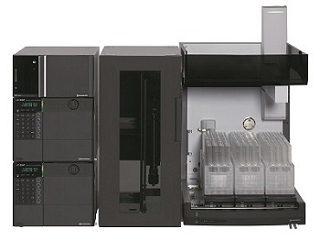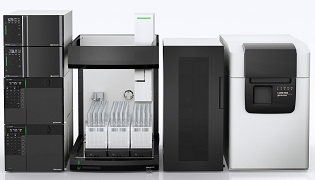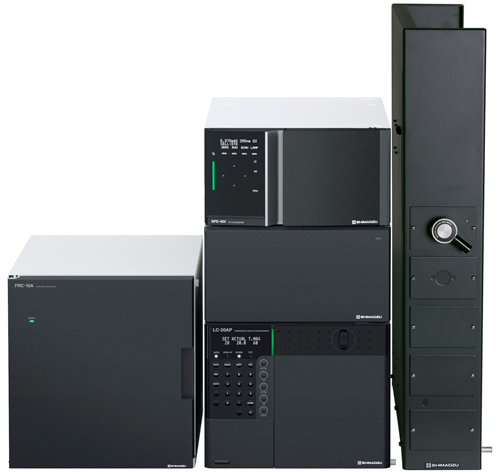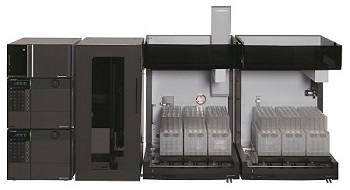Nexera Prep - Features
Preparative Purification Liquid Chromatograph
Streamline and Simplify Establishing the Conditions for Preparative Work
Streamline development of Analysis Conditions and Optimization of Preparative Parameters

Nexera Prep System
Using the Nexera™ Prep system saves on labor when scaling up from the development of analytical conditions to the conditions for preparative work.
- Fraction Collector FRC-40
- Liquid handler
In order to separate multiple components, the analysis and fractionation parameters must be optimized, which involves a great deal of work.
Shimadzu provides the Method Scouting system, which investigates conditions at the analytical level. Method Scouting system fully automates method scouting in which combinations of mobile phases and columns are automatically changed, equilibrated, and evaluated, allowing efficient method development.
Further, the preparative system performs automatic simulations using the pre-preparative results, enabling optimization of the fractionation parameters.
This reduces the work involved in investigating conditions, which saves on mobile phase solvent and samples.
Development of Analytical Conditions (Method Scouting System)

A development is performed to separate the target compounds at the analysis level.
Using the Shimadzu Method Scouting system together with Method Scouting Solution, a special software program, provides a fast and accurate method scouting workflow, which supports heightened efficiency in method development.
Significantly Reduces the Process of Setting Fractionation Parameters
Simple parameter setting by fraction simulator
LabSolutions™ software provides simulation functions that reduce the labor involved in investigating conditions for analytical and preparative work.
With the LabSolutions fractionation simulator (patent pending), specify the peak segment in the chromatogram to fractionate, and the system automatically sets the parameters required for fractionation. This reduces the time spent on setting fractionation conditions to about 1/4 the typical expenditure.

Noise skipping by new algorithm
When configuring fractionation via automatic peak recognition, noise in the chromatogram is sometimes mistaken for component peaks, resulting in an insufficient number of test tubes for intended collection or improper positioning of collected fractions. With the LabSolutions software Peak Sensitivity Determination function (patent pending), peaks are recognized from the number of data points consecutively exceeding the configured threshold value, to determine whether to fractionate.

Fraction Purity Checks(LH-40)
A fraction purity check can easily be performed with a single system. Purity checks can be performed without changing the fraction recovery container, so the workload is reduced and throughput is improved.

Sample rescue function prevents the loss of precious samples(LH-40, FRC-40)
Even if a problem occurs during preparative work, the sample remaining in the system can be recovered. By following the rescue instructions, the precious sample is recovered into the specified container rather than being discarded. Additionally, by using the optional waste collector, samples that cannot be recovered due to fractionation mistakes can be retained.

Preparative Work for Target Components at High Purity Levels and High Concentrations
The Shimadzu UFPLC, Ultra Fast Preparative and Purification Liquid Chromatograph significantly reduces the cost and labor involved in preparative purification.
Additionally, the system not only performs purification of target components, but can also recover impurities with high yield enabling direct impurity analysis.
Significantly Reduces the Processes Involved from Preparative Work to Purification (Free basing Treatment) and Powderization
With conventional preparative methods, the fractionated sample contains mobile phase solvent, which leads to unavoidable dilution during fractionation, so the fractionated sample must be enriched and desalted. Such procedures complicate the workflow, and amplify sample loss, labor, and costs.
With the Shimadzu UFPLC Ultra Fast Preparative and Purification Liquid Chromatograph, all the work from preparation to enrichment, purification, and recovery is performed on-line. This significantly reduces the labor involved in the preparative purification process, and avoids procedural mistakes. Using a proprietary trap enrichment purification technology for the fractionated target components, trace quantities of components contained in mixtures can be recovered at high concentrations and high purity levels. Additionally, since highly volatile organic solvents are used for the recovery of target components, the time needed for evaporation to dryness can be significantly reduced. When recovering ionic target components, counter ions are flushed out by optimization of the solution flowing through, so the target component is recovered as a high purity free base. With these procedures, and the dedicated Purification Solution™ software, the entire process from the configuration of preparative conditions to the recovery of liquid containing the target compounds can be configured easily from simple and user friendly software.

Automation of the Preparative Purification Process
When target compounds are to be powderized, this process can be hindered by a number of factors including the presence of acids, salts, and refractory solvents. With the UFPLC Ultra Fast Preparative and Purification Liquid Chromatograph, these hindrances to powderization can be removed by flushing them out using a trap column, allowing a high purity powder of the target component to easily be obtained by anyone.
Even Trace Components Are Recovered at High Concentrations
Normally, when preparing trace quantity target components, preparative work involves injecting the sample multiple times to obtain sufficient amounts of the target. As a result, the volume of fractionation liquid ultimately obtained increases in proportion to the number of injections, increasing solvent use and dry down time. With the UFPLC Ultra Fast Preparative and Purification Liquid Chromatograph, even with multiple injections, the fraction of the target component is injected into the same trap column for enrichment. The final volume of fractionated liquid from the trap column is minimized, exchanging the weaker loading solvent for a suitable organic solvent. The target component can then be recovered at high purity levels and at high concentrations.
Purification Solution Simplifies Settings Related to Preparative Purification
The special Purification Solution software is equipped with peak tracking functions that enable the target peaks and fractionate and be checked at a glance.

Applications

Removal of Ammonium Chloroacetate Salts from Ibuprofen
Ibuprofen, the target component, is cleaned by retention in a trap column. As a result, the ammonium chloroacetate salts contained in the mobile phase solvent were removed. This can prevent the retention of salts contained in the mobile phase solvent during powderization, so that only the target component is recovered.

Heightening the Efficiency of Enrichment Purification for Trace Components
High Speed Powderization of Cyclosporine A
The target compound fraction is repeatedly injected into the trap Ibuprofen column, enriched by trapping, and eluted by an organic solvent. This enables recovery with a smaller volume of liquid, so subsequent powderization can be performed in a shorter time. In this way, the same volume of powdered sample can be purified in a shorter time versus elution in reverse phase conditions.

Preparative Work for Non-UV Absorptive Components

Preparative LCMS System
With LH-40 and FRC-40 able to perform signal-based logic and collection on up to four signal channels, not having a chromophore is not a limitation. Nexera Prep can use LCMS, RID, and ELSD to detect and/or identify targets for purification.
Using MS Signal Triggers Enables Recovery with no Target Fraction Omissions
It can be difficult to prepare low UV absorptive components using just a UV signal as the trigger, so there is a risk that the fraction will be missed.
By using the MS signal as the trigger, the preparative work can be performed simply, with nothing missed. By specifying the m/z of the target component, fractions can be collected with confidence. The LCMS-2020 mass spectrometer enables high-sensitivity and high-resolution detection for preparative work with no target components omitted.

High Purity Recovery of Target Components Using Multiple Signal Triggers
By combining up to four detector signal channels, target components can be recovered at high purity levels.

The MS signal from the detection of target component A is used as the trigger to start fraction collection. The MS signal from the detection of impurity B, which is eluted in proximity, is used as the trigger to stop fraction By combining multiple triggers in this way, it is possible to recover only the target component at high purity level. Combining a variety of detector signals as triggers, targets can be recovered at high purity levels, with the confidence that all peaks were detected.

Optional Analytical and Preparative Open Solution™ Software Simplifies
Preparative Operations and Data Analysis
Efficient System Sharing via Open Access

Open Solution simplifies the sharing of preparative systems between several people.
There is a special sample registration window, so preparative work can be performed easily just by having users log in and then specify their method, injection volume and target m/z.
Preparative Operations and Data Analysis can be Performed from a Single Window
With the Open Solution data browser, preparative results can be checked from a single window.
When the test tubes are selected, the peaks are highlighted, and the MS spectrum and UV spectrum for the applicable peak are displayed.
The information for the fractionated compound can be checked easily.

* This is compatible with the FRC-10A.
High Separation via Preparative Recycling

Recycling Preparative System
By repeatedly cycling the sample through the column, the target component can be resolved and recovered from coeluting species or impurities without the need for longer or multiple columns.
What is the recycling separation method?
Long preparative columns are expensive, as such there is a need to use comparatively lower cost short columns effectively.
In the recycling separation method (closed valve recycling), the eluate liquid containing the target components that has eluted from the separation column is recycled into the column, enabling an equivalent separation capacity to that of a longer column.

The figure below shows the results of a seven-cycle recycling separation. In the first injection (typical separation), the separation of the two components is insufficient (red area). However, when the column eluate is returned to the column from the detector, it is separated a second time. If this recycling is repeated, the results obtained are equivalent to connecting a number of columns in series corresponding to the number of repetitions. In this example, a 4.0 or better resolution was ultimately obtained with seven recycling separation cycles (blue area).

Example of the improvement in separation by recycling : The coeluting peaks (red) are completely separated (blue).
Flowrate : 10 mL/min
Detection wavelength : 254 nm
Column : Shim-pack PREP-ODS(H) 20 mm I.D. x 250 mm L.
Mobile phase : Water/methanol = 1/9 (v/v)
Sample : Mixed 1% n-butylbenzene/iso-butylbenzene solution
Recycle-Assist - Special Preparative Recycling Software*
Perform Automatic Preparative Recycling with a Simple GUI-Based Operating Environment
The graphical user interface (GUI) provides an environment where even novices to preparative recycling can perform operations simply and reliably. A single main window is used for the workflow from recycling to fractionation, thus reducing the risk of wasting precious samples through setting mistakes.

Recycling Conditions are Completely Set in Three Steps
Just click three points corresponding to the recycling start, recycling stop, and automatic collection start point to complete the settings for the recycling preparation conditions. Entering complicated numerical parameters is completely unnecessary, so recycling preparative work can start easily.

* This is compatible with the FRC-10A
Excellent System Expandability

Multi Fraction Collector System
The solvent delivery unit and fraction collector can be selected to suit the recovery volume.
Additionally, the Shim-pack™ Scepter features excellent scalability from analysis to preparative work, and the preparation of a variety of components is supported by an ample lineup.


